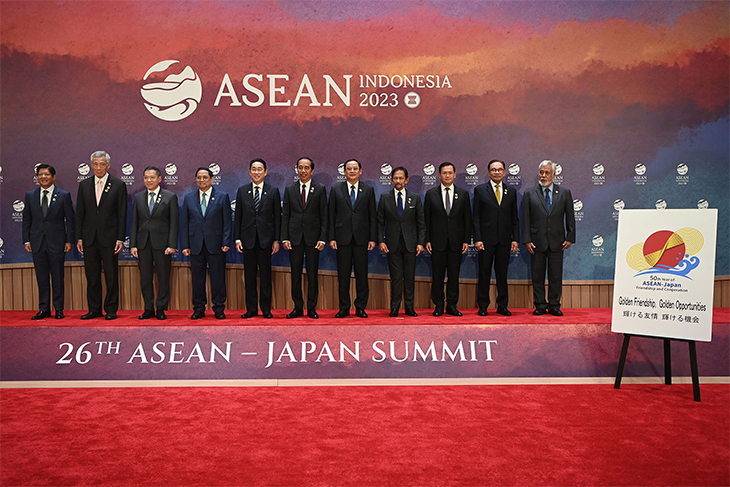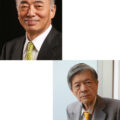Japan-ASEAN: “50 Years” of Friendship and Future Challenges

The 26th ASEAN-Japan Summit was held in Jakarta, Indonesia, on 6 September 2023.
Photo: Cabinet Public Affairs Office
Oba Mie, Professor, Kanagawa University
When ASEAN was established in August 1967, Japan’s interest in the organization was low. However, since the mid-1970s, Japan’s policy toward Southeast Asia began to emphasize the unity of ASEAN and to promote friendly cooperation with it. This came at a time when Japan was being forced to make a major review of its policies towards the region, with Southeast Asian countries facing harsh scrutiny over Japan’s economic overpresence and ODA. The 1973 Japan-ASEAN Synthetic Rubber Forum is now considered the starting point for Japan-ASEAN friendship and cooperation. Prime Minister Fukuda Takeo’s Manila speech (the so-called Fukuda Doctrine) in 1977 was another extremely important event for the development of friendship and cooperation between Japan and ASEAN.
Currently, there are no serious issues of concern between Japan and the ASEAN countries that have become politicized. On the contrary, The State of Southeast Asia, published annually by the ISEAS-Yusof Ishak Institute, shows a high degree of “trust” in Japan among Southeast Asian countries. On the other hand, it should not be overlooked that the numbers recorded are extremely low for items that question Japan’s future influence in the region, both in terms of security and the economy. Nowadays, ASEAN governments and private sectors have a variety of choices, including China, the United States, South Korea, Europe, the United Kingdom, Russia, and India, whether they are looking for aid and loans or business partnerships. Japan is just one of them.
Also, it cannot be overlooked that the ASEAN countries themselves are developing. Of course, there are considerable differences in the degree of development of each ASEAN country. With the exception of Singapore and Brunei, countries such as Malaysia, Indonesia, Thailand, the Philippines, and Vietnam, which continue to develop, seem to have difficulty escaping the middle-income trap. Of course, Japan’s support for developing countries through ODA and other means continues in this region. Additionally, the way Japanese companies do business in this region is changing. For example, the involvement of Japanese trading and real estate companies in smart city planning, the entry of Japanese startup companies in Digital Transformation (DX) projects, and the global business development of Japanese banks may be expanding their presence differently from the way Japanese products used to dominate the ASEAN market.
On the other hand, these countries cannot be classified as “developing countries” as they have the aspect of donors when it comes to investment and aid. Japan itself is suffering from the weak yen, and its GDP and per capita GDP are slowly declining without a clue to revitalizing the economy. Under such circumstances, the gap between Japan and these countries has narrowed, and there is little admiration for Japan in Southeast Asia, especially among the younger generation.
However, as Japan’s presence has become relative, Japan is now in a situation where it must further strengthen its partnership with ASEAN. First, in response to the turmoil in the regional order caused by the escalating conflict between the United States and China, we must work together to maintain a rules-based international order. Although China is a security concern given its aggressive and provocative actions in the East China Sea and South China Sea, and the possibility of an emergency in Taiwan, it is economically important to both Japan and the ASEAN countries. Above all, it will be difficult in the long run to ignore or exclude neighboring China. The deepening of US coordination and cooperation with allies in the region under the Biden administration is a welcome signal of America’s continued commitment to security and peace in the region. However, the deep divisions in American society have destabilized the country’s domestic politics and, as a result, narrowed the scope of its foreign policy. Furthermore, depending on the outcome of next year’s presidential election, there is a possibility that America’s involvement in the region will decline significantly. It would be too utopian to say that the power vacuum at that time would be filled through Japan-ASEAN cooperation. However, in order to support the rules-based order in the region while ensuring a stable relationship with China, it is now necessary for Japan and the ASEAN countries to work together to strengthen their capabilities to support the regional order. In fact, security cooperation is being strengthened, with defense equipment and technology transfer agreements concluded between Japan and five of the ASEAN countries, and the 2+2 talks with Indonesia and the Philippines. For the ASEAN countries, Japan is likely to be one of their partners in mitigating the negative impact of the escalating strategic competition between the United States and China and increasing their own strategic independence.
Another new reality brought about by the intensifying Sino-US rivalry is the growing logic of economic security, in which geopolitical demands restrict and control economic activity. The Indo-Pacific Economic Framework (IPEF) and other organizations are considering creating rules to ensure a stable access to critical materials and to build supply chains that do not rely too heavily on China. Japan and the ASEAN countries should take the lead in creating rules that allow de-risking to coexist with maintaining the free and open economic order that has brought economic prosperity to East Asia. Furthermore, greater cooperation between Japan and ASEAN is required on global issues that will significantly change the world’s future, such as responses to the environment and climate change, Green Transformation (GX) and DX. Of course, this will depend on how private enterprises in both countries can be actively involved in various projects and cooperate with each other, even if an enabling environment for cooperation is created at the governmental level.
For ASEAN countries, the existence of “ASEAN” is a mechanism to stabilize relations between them. At the same time, it is also a device for giving a regional “voice” to the outside world, having their will reflected in maintaining regional order, and preventing them from being swamped by the wishes of major powers. ASEAN countries have maintained and strengthened their relationships with other countries, such as China, the United States, Europe, and India, both individually and through ASEAN. In seeking to play its role as a promoter in shaping a desirable regional environment, Japan will promote cooperation tailored to the circumstances of individual ASEAN countries, and at the same time promote cooperation to strengthen the unity and centrality of ASEAN. The “heart-to-heart” dialogue emphasized in Fukuda’s Manila speech of 1977 remains an important theme today. However, this will be meaningless unless it goes beyond fostering an atmosphere of abstract friendship and leads to aligning each other’s visions and interests, and advancing substantive cooperation as promoters of regional order.
Translated from an original article in Japanese written for Discuss Japan. [December 2023]
Keywords
- Oba Mie
- Kanagawa University
- ASEAN
- Japan-ASEAN
- 50 years
- friendship
- cooperation
- Southeast Asia
- Fukuda Doctrine
- developing countries
- ODA
- middle-income trap
- weak yen
- US-China conflict
- regional order
- rules-based order
- security cooperation
- supply chains
- “heart-to-heart”





